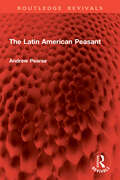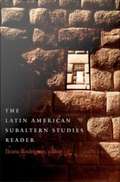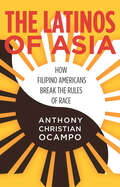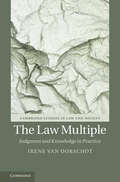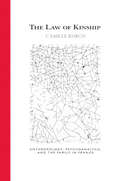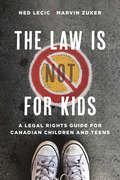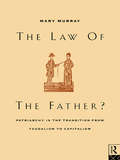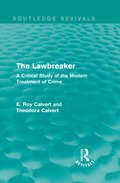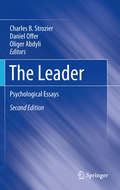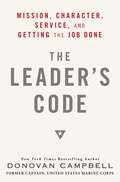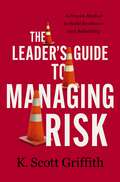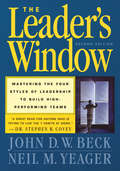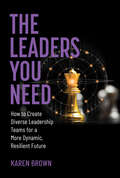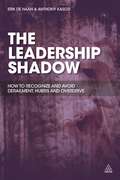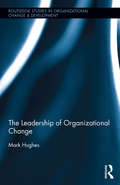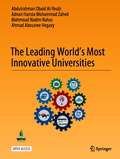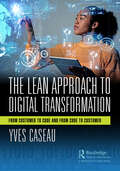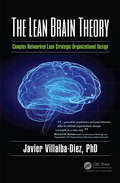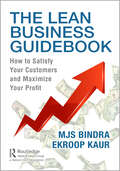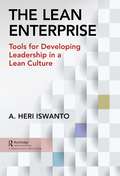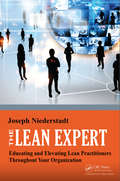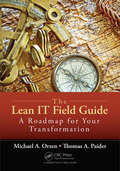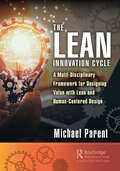- Table View
- List View
The Latin American Peasant (Routledge Revivals)
by Andrew PearseFirst Published 1975, The Latin American Peasant is not a historian’s book, the presentation is rather sociological in that it seeks to explain the working out of a process of social transformation and the social forces which are released by the pursuit of common interests by social entities such as classes and territorial groups, and the pursuit of a vision of livelihood by individuals and families.The peasant, in the sense of this book, is the agricultural producer and cottage craftsman of pre industrial and partially industrial societies, who produces for the provisioning of his own household, and for market exchange, and lives in land groups. The concept peasant, taken as equivalent of the word campesino or campones, does have both historical and geographical reality in the Latin American context. The book discusses important themes such as land labor institutions in Latin America; peasant action; the transformation of the estate; peasants and revolution in Bolivia; and peasant organization and peasant destinies. This this is an important book for scholars and researchers of Latin American sociology, rural sociology, historical sociology and sociology in general.
The Latin American Subaltern Studies Reader
by Ileana RodríguezSharing a postrevolutionary sympathy with the struggles of the poor, the contributors to this first comprehensive collection of writing on subalternity in Latin America work to actively link politics, culture, and literature. Emerging from a decade of work and debates generated by a collective known as the Latin American Studies Group, the volume privileges the category of the subaltern over that of class, as contributors focus on the possibilities of investigating history from below. In addition to an overview by Ranajit Guha, essay topics include nineteenth-century hygiene in Latin American countries, Rigoberta Mench after the Nobel, commentaries on Haitian and Argentinian issues, the relationship between gender and race in Bolivia, and ungovernability and tragedy in Peru. Providing a radical critique of elite culture and of liberal, bourgeois, and modern epistemologies and projects, the essays included here prove that Latin American Subaltern Studies is much more than the mere translation of subaltern studies from South Asia to Latin America. Contributors. Marcelo Bergman, John Beverley, Robert Carr, Sara Castro-Klarn, Michael Clark, Beatriz Gonzlez Stephan, Ranajit Guha, Mara Milagros Lpez , Walter Mignolo, Alberto Moreiras, Abdul-Karim Mustapha, Jos Rabasa, Ileana Rodrguez, Josefina Saldaa-Portillo, Javier Sanjins, C. Patricia Seed, Doris Sommer, Marcia Stephenson, Mnica Szurmuk, Gareth Williams, Marc Zimmerman
The Latinos of Asia
by Anthony OcampoIs race only about the color of your skin? In The Latinos of Asia, Anthony Christian Ocampo shows that what "color" you are depends largely on your social context. Filipino Americans, for example, helped establish the Asian American movement and are classified by the U.S. Census as Asian. But the legacy of Spanish colonialism in the Philippines means that they share many cultural characteristics with Latinos, such as last names, religion, and language. Thus, Filipinos' "color"--their sense of connection with other racial groups--changes depending on their social context. The Filipino story demonstrates how immigration is changing the way people negotiate race, particularly in cities like Los Angeles where Latinos and Asians now constitute a collective majority. Amplifying their voices, Ocampo illustrates how second-generation Filipino Americans' racial identities change depending on the communities they grow up in, the schools they attend, and the people they befriend. Ultimately, The Latinos of Asia offers a window into both the racial consciousness of everyday people and the changing racial landscape of American society.
The Law Multiple: Judgment and Knowledge in Practice (Cambridge Studies in Law and Society)
by Irene van OorschotIn the field of socio-legal studies or law and society scholarship, it is rare to find empirically rich and conceptually sophisticated understandings of actual legal practice. This book, in contrast, connects the conceptual and the empirical, the abstract and the concrete, and in doing so shows the law to be an irreducibly social, material and temporal practice. Drawing on cutting-edge work in the social study of knowledge, it grapples with conceptual and methodological questions central to the field: how and where judgment empirically takes place; how and where facts are made; and how researchers might study these local and concrete ways of judging and knowing. Drawing on an ethnographic study of how narratives and documents, particularly case files, operate within legal practices, this book's unique and innovative approach consists of rearticulating the traditional boundaries separating judgment from knowledge, urging us to rethink the way truths are made within law.
The Law Of Kinship
by Camille RobcisIn France as elsewhere in recent years, legislative debates over single-parent households, same-sex unions, new reproductive technologies, transsexuality, and other challenges to long-held assumptions about the structure of family and kinship relations have been deeply divisive. What strikes many as uniquely French, however, is the extent to which many of these discussions-whether in legislative chambers, courtrooms, or the mass media-have been conducted in the frequently abstract vocabularies of anthropology and psychoanalysis. In this highly original book, Camille Robcis seeks to explain why and how academic discourses on kinship have intersected and overlapped with political debates on the family-and on the nature of French republicanism itself. She focuses on the theories of Claude Levi-Strauss and Jacques Lacan, both of whom highlighted the interdependence of the sexual and the social by positing a direct correlation between kinship and socialization. Robcis traces how their ideas gained recognition not only from French social scientists but also from legislators and politicians who relied on some of the most obscure and difficult concepts of structuralism to enact a series of laws concerning the family. Levi-Strauss and Lacan constructed the heterosexual family as a universal trope for social and psychic integration, and this understanding of the family at the root of intersubjectivity coincided with the role that the family has played in modern French law and public policy. The Law of Kinship contributes to larger conversations about the particularities of French political culture, the nature of sexual difference, and the problem of reading and interpretation in intellectual history.
The Law is (Not) for Kids: A Legal Rights Guide for Canadian Children and Teens
by Ned Lecic Marvin A. ZukerIn this practical guide to the law for young people of Canada, Ned Lecic and Marvin Zuker provide an all-encompassing manual meant to empower and educate children and youth and those that serve them. The authors address questions about how rights and laws affect the lives of young people at home, at school, at work, and in their relationships as they draw attention to the many ways in which a person’s life can intersect with the law. Deliberately refraining from taking a moral approach, the authors instead advocate for the rights of children and provide examples of how young people can get their legal rights enforced. In addition to being critical information for youth about citizenship, The Law is (Not) for Kids is a valuable resource for teachers, counsellors, lawyers, and all those who support youth in their encounters with the law.
The Law of the Father?: Patriarchy in the transition from feudalism to capitalism
by Mary MurrayA coherent and focussed exploration into how Patriarchy constructed pre-capitalist and capitalist society, and its role in the transition from feudalism to capitalism.
The Lawbreaker: A Critical Study of the Modern Treatment of Crime (Routledge Revivals)
by E. Roy Calvert Theodora CalvertThe early 21st century saw better prison conditions and a lower imprisonment rate however public worry over supposed increasing violent crime as perpetuated by the media in the 1930’s led to a return to harsher sentences and fuller prisons. Originally published in 1933, The Lawbreaker analyses British penal methods of the time and of the past to discover the most effective ways to treat prisoners and reduce crime as well as identifying where more research is needed to obtain a balance between punishment and rehabilitation. This title will be of interest to students of Criminology and Sociology.
The Leader
by Charles B. Strozier Daniel Offer Oliger AbdyliThis volume examines the lives of prominent leaders from ancient Greece to the present. It explores how these leaders imposed their individual missions and mystiques on others, thereby fulfilling , and sometimes creating, distinct needs in their followers.
The Leader's Code: Mission, Character, Service, and Getting the Job Done
by Donovan CampbellWhat does it take to be a great leader? In a word: character. This unique book by decorated U.S. Marine Corps veteran Donovan Campbell, the New York Times bestselling author of Joker One, draws on his years of training and combat experience to reveal the specific virtues that underpin effective leadership--and how anyone can stand up, serve others, and make a difference in the world by bringing out the best in a team. The Leader's Code is a practical action plan that can be applied to any situation in which exemplary leadership is required, whether that be at home or in the workplace. Moreover, The Leader's Code unpacks the military servant-leader model--a leader must take care of his mission first, his team second, and himself a distant third--and explains why this concept of self-sacrifice is so needed in today's world. Focusing on the development of character as the foundation of servant-leadership, Campbell identifies character's six key attributes: humility, excellence, kindness, discipline, courage, and wisdom. Then, drawing on lessons from his time in the Corps and stories from history, Scripture, and American business, he shows us how to develop those virtues in order to take the helm with confidence, conviction, and a passion to bring out the best in others. Being a leader is about being worthy of being followed. True leaders, Campbell argues, foster compassion for others and they pursue excellence in all that they do. They are humble and know how to self-correct. Campbell's exploration of these vital qualities is wide-ranging, as he takes us from the boardrooms of the world's most successful companies to the Infantry Officer Course, the intense twelve-week training gauntlet that Marines use to prepare their leaders to sacrifice themselves for the welfare of others. With faith in our political and business leaders at an all-time low, America is in the midst of a crisis of trust. Yet public opinion polls show that there is one institution that still commands widespread respect because of its commitment to character and sacrifice: the United States military. The Leader's Code shows that this same servant-leader model can help us all become our best selves--and provide a way forward for our nation.Advance praise for The Leader's Code "A refreshing model for leadership, offering convincing principles and motivating examples that are sure to make a difference in a leader's personal and professional life. I can't remember a leadership book that has had more influence on my thinking."--Steve Reinemund, dean of business, Wake Forest University, and retired chairman and CEO, PepsiCo "Donovan Campbell has written a superb, thoughtful, all-encompassing examination of leadership and leaders. His key lessons, easily understood and well articulated, are applicable at home, within the community, and to professionals in all walks of life. The Leader's Code is an important book for anyone concerned about today's leadership crisis in our country and in our communities."--General Mike Hagee, USMC (Ret.), 33rd Commandant of the U.S. Marine Corps "Donovan Campbell nails it as he speaks to our country's need for leadership at every level: at home, in the marketplace, in education, in government, and in the military. The Leader's Code is a clear call to be focused on the right mission, in the right way, and at the right time. This is a thoughtful book that will keep you awake at night and challenge you to dream in the daytime!"--Dennis Rainey, president and CEO, FamilyLifeFrom the Hardcover edition.
The Leader's Guide to Managing Risk: A Proven Method to Build Resilience and Reliability
by K. Scott GriffithBe prepared for the dangerous and largely unknown risks that threaten your business and learn how to survive and thrive when uncertainty hits.Leaders today must navigate their teams and organizations through unprecedented levels of uncertainty. It feels like every year there is some-game changing technology or catastrophe that gives rise to a &“new normal&” and sends businesses scrambling for how to rethink themselves to operate under these new conditions. In The Leader&’s Guide to Managing Risk, K. Scott Griffith, a former airline pilot, socio-technical physicist, and author of the first independently-audited high reliability and just culture model offers practical and proven methods to build processes that will withstand the winds of uncertainty while driving success. By understanding that organizations are people operating within systems, leaders of all kinds will build reliability and resiliency into their culture and set up their business to withstand the next big changes that come their way. Learn a new way of seeing, understanding, and managing risk.Understand how people and systems interact in organizations and how to build processes that increase resilience and performance.Collaborate with all stakeholders, including employees, to help you foresee dangers and achieve sustainable reliability.Implement proven methods from Scott&’s award-winning model that is being used in some of the most prestigious healthcare, EMS, and transportation companies in the world.Achieve independent validation of success through certification.
The Leader's Window: Mastering the Four Styles of Leadership to Build High-Performing Teams
by John D.W. Beck Neil YeagerThe Leader's Window presents an authoritative leadership system to help you give your employees what they need, when they need it, in a form in which they can use it. New and updated leader profiles and case examples illustrate the variety of successful strategies high-profile leaders use, while stories of misguided leadership show pitfalls to avoid. With new information on managing Generation X and adapting to diverse personality types, this classic resource presents the strategies you need to make the most of individual capabilities and simultaneously achieve goals. Charts, action lists, cases for reflection, process plans, performance contracts, self-assessments and tools to crease baseline leadership measures provide the help you need to harness the potential of each worker and transform that potential into results-driven teams.
The Leaders You Need: How to Create Diverse Leadership Teams for a More Dynamic, Resilient Future
by Karen BrownAn innovative, field-tested framework for leaders and managers on how to create more diverse leadership and management teams.We need the strength that comes from diversity more now than we ever have in our collective memory. Without leadership teams that reflect the full range of humanity, for-profit and nonprofit organizations alike will find it more difficult to confront today’s challenges and are unlikely to thrive in the long term. But no two organizations have the same need for greater diversity in leadership nor the same path to achieving it. In The Leaders You Need, Karen Brown offers an innovative, field-tested ABCD Framework that will help readers to discover the hidden leadership and management talent in their organizations—and how to harness it. Karen Brown shares the approach she has used to guide organizations from small nonprofits to the Global 500 on their journey to greater diversity in leadership and management. Her framework consists of four pillars:• How to align diversity, equity, and inclusion efforts with business priorities• How to build strong partnerships with stakeholders• How to cultivate a culture of role models• How to define objectives and outcomes with dataReaders will learn how to use the framework to identify and dismantle the barriers to greater leadership and management diversity in their organizations. What’s more, they will get practical advice on how to become inclusive leaders who create opportunities for everyone on their teams to learn, grow, and fulfill their potential.
The Leadership Roadmap: People, Lean, and Innovation, Second Edition
by Dwane Baumgardner Russell ScaffedeFor more than 60 years, a few organizations have followed what is known as the "Scanlon Plan" for employee engagement. Some early benefits were achieved and employee satisfaction was high in these companies, such as Donnelly Corporation and Herman Miller Office Furniture. Likewise, for more than 30 years now, US and European companies have been studying and adapting the Toyota Production System (TPS), which has been dubbed as "Lean." Again, some long-term benefits have been achieved, but many have not transformed their workplace culture or achieved operational excellence. The Leadership Roadmap combines the two philosophies of both employee engagement and Lean into one concise and understandable system for leaders to follow. If leaders truly want success like Toyota, they must understand it is the combination of TPS with total employee engagement that made this company a sustaining industry leader. By following the outlined system, leaders will not only make a more successful organization for all stakeholders but will truly enhance their employee satisfaction with their daily work. This book is not just for CEOs, CFOs, and others at the executive level – it is for employees in human resources or project development, the plant manager or first line supervisor. Essentially, it is for anyone in the organization who shares a strong commitment to the foundational premise of integrating the leadership of people, Lean transformation, and innovation systems. The Leadership Roadmap is a practical resource that will foster a new generation of roving leaders -- committed team members who are willing to step up and fill a void and who lead by asking questions that trigger positive change rather than simply giving orders. These new leaders will understand that while the framework for achieving success is simple, the implementation can be complex and daunting, requiring a firm and enduring dedication to renewal, and a step-by-step guide to show them the way.
The Leadership Shadow
by Erik De Haan Anthony KasoziIn today's fast paced, interconnected, and mercilessly competitive business world, senior executives have to push themselves and others hard. Paradoxically, to succeed as leaders, they also need to relate to others very well. Under stress and challenge, the qualities executives have relied on to get them to the top and to achieve outstanding results can overshoot into unhelpful drives that lead to business and personal catastrophes.The Leadership Shadow draws on the lived experience of executives to make sense of what actually happens when their drivers overshoot and they act out the dark side of leadership. It shows how executives can find stability in the face of uncertainty, resilience in the face of gruelling demand, and psychological equilibrium as a leader in the face of turbulence.
The Leadership of Organizational Change (Routledge Studies in Organizational Change & Development)
by Mark HughesUnderstanding both leadership and change have been recurrent and popular themes within the business, management and organization studies literature. However, our understanding of leadership and organizational change in combination is far more limited. The Leadership of Organizational Change offers a critical review of the evolution of leadership and organizational change for the past thirty-five years, taking stock of what we know, identifying what we do not know, and establishing how the study of the leadership of change should advance. In the late seventies and early eighties, as interest in managing and leading change was fuelled by the competitive threat of Asia in general and Japan in particular as perceived by western businesses and governments, Burns (1978) writing in his landmark book Leadership at this time, referred to an intellectual crisis: "The crisis of leadership today is the mediocrity or irresponsibility of so many of the men and women in power, but leadership rarely rises to the full need for it. The fundamental crisis underlying mediocrity is intellectual. If we know all too much about our leaders, we know far too little about leadership." While the study of managing change has benefitted from sustained critical scrutiny, particularly in the last decade, it is believed that this is to have been at the expense of critical scrutiny of leading change. The Leadership of Organizational Change critically reviews how the study of leading change has advanced since 1978 and the crisis of intellectual mediocrity.
The Leading World’s Most Innovative Universities
by Abdulrahman Obaid AI-Youbi Adnan Hamza Zahed Mahmoud Nadim Nahas Ahmad Abousree HegazyThis open access book is unique in its contents. No other title in the book market has tackled this important subject. It introduces innovation as a way of practice for world-class universities. It, then, discusses the criteria for being innovative in the academic world. The book selects some of the top innovative world-class universities to study the factors that qualified them to be innovative, so that any other university can follow their steps to become innovative. The final chapter of the book presents some recommendations in this regard.
The Lean Approach to Digital Transformation: From Customer to Code and From Code to Customer
by Yves CaseauThe Lean Approach to Digital Transformation: From Customer to Code and From Code to Customer is organized into three parts that expose and develop the three capabilities that are essential for a successful digital transformation: 1. Understanding how to co-create digital services with users, whether they are customers or future customers. This ability combines observation, dialogue, and iterative experimentation. The approach proposed in this book is based on the Lean Startup approach, according to an extended vision that combines Design Thinking and Growth Hacking. Companies must become truly "customer-centric", from observation and listening to co-development. The revolution of the digital age of the 21st century is that customer orientation is more imperative -- the era of abundance, usages rate of change, complexity of experiences, and shift of power towards communities -- are easier, using digital tools and digital communities. 2. Developing an information system (IS) that is the backbone of the digital transformation – called “exponential information system” to designate an open IS (in particular on its borders), capable of interfacing and combining with external services, positioned as a player in software ecosystems and built for processing scalable and dynamic data flows. The exponential information system is constantly changing and it continuously absorbs the best of information processing technology, such as Artificial Intelligence and Machine Learning. 3. Building software “micro-factories” that produce service platforms, which are called “Lean software factories.” This “software factory” concept covers the integration of agile methods, tooling and continuous integration and deployment practices, a customer-oriented product approach, and a platform approach based on modularity, as well as API-based architecture and openness to external stakeholders. This software micro-factory is the foundation that continuously produces and provides constantly evolving services. These three capabilities are not unique or specific to this book, they are linked to other concepts such as agile methods, product development according to lean principles, software production approaches such as CICD (continuous integration and deployment) or DevOps. This book weaves a common frame of reference for all these approaches to derive more value from the digital transformation and to facilitate its implementation. The title of the book refers to the “lean approach to digital transformation” because the two underlying frameworks, Lean Startup and Lean Software Factory, are directly inspired by Lean, in the sense of the Toyota Way. The Lean approach is present from the beginning to the end of this book -- it provides the framework for customer orientation and the love of a job well done, which are the conditions for the success of a digital transformation.
The Lean Brain Theory: Complex Networked Lean Strategic Organizational Design
by Javier Villalba-Diez, PhDThe most complex organization known in the universe is inside of our heads: our brain. Because organizations are formed by human beings, The Lean Brain Theory aims to mimic human brain structure and functionality so as to enable the emergence of brain-like organizations in which the 'neurons' are the human-beings and the 'axons' ought to be Lean Management oriented behavioral and communication patterns. These networks ought to evolve towards brain-like configurations that display thinking-like processes and ultimately organizational consciousness. The Lean Brain Theory offers a quantifiable holistic framework to strategically design any organization as a human brain. By embedding complexity into the Strategic Organizational Design (SOD) and combining this with Lean Management and neuropsychological state of the art knowledge, The Lean Brain Theory ends up with the Brain-Organization metaphor and makes it possible. This idea of embedding complexity into organizational design is a follow up to the book The Hoshin Kanri Forest. That book dealt with the methodology of creating 'forest-like' topologies. The Lean Brain Theory aims to set the ground for Lean organizations of the future that embrace both Business Intelligence and Complex Networked Lean Strategic Organizational Design. The organization as a super-network evolves towards 'intelligent' Human-Brain-like entity. The Lean Brain Theory ultimately seeks to integrate an anthropomorphic organizational paradigm with future tendencies of technological advances. In this way, the brain-like organization emerging from it can be regarded as bionic.
The Lean Business Guidebook: How to Satisfy Your Customers and Maximize Your Profit
by MJS Bindra Ekroop KaurThis book introduces a powerful system that explains how to run a company with a focus on continuous improvement – The results are a satisfied customer base, evolving products, and an increase in revenue and profits. These factors determine the success for any company because business transformation involves making fundamental changes in how business is conducted to cope with shifts in the market environment. This a comprehensive book for valuable guidance on framing strategy and overcoming challenges for successful and sustainable implementation of a Lean production system, daily management system, and a Lean accounting system in companies to empower the managers to serve their customers with timely delivery of quality products while maximizing profits and easing workloads. The main challenge is ensuring operational colleagues in different functions understand the link between their daily work and the profit and loss statement. In addition, it illustrates how finance personnel can assist the operations team and be a part of the transformation journey. This book is not meant to impart theoretical knowledge of the Lean production system, daily management, and Lean accounting as there are many books already available that focus on the methodology instead of the implementation. This book empowers people in each function of a company, irrespective of which level they work in the company, and shows them the way to operate on a daily basis to achieve the strategy of the company while simultaneously fulfilling their career goals. The book lays out a brief history of the evolution of Lean concepts, with a focus on lean accounting. This book guides the successful implementation and sustenance of Lean and kaizen tools and provides answers to the questions: • Who should lead Lean and kaizen implementation in the company? • Where should the Lean and kaizen journey begin? • Which Lean and kaizen tools should be implemented first? • How important is capacity for the company? • How much current capacity is wasted and how much free capacity is available? • Where exactly are the resources being wasted in the company? • How to reduce waste to release capacity for more production? • Why daily management system and Lean accounting system should be implemented simultaneously with the Lean production system? • Why managers must understand the monetary value of their daily activities? • Is there an easy way of making a profit and loss statement that is understood at each level in the company? • Why one-day closing of accounts is important and how can it be done?
The Lean Enterprise: Tools for Developing Leadership in a Lean Culture
by A. Heri IswantoLean culture should be developed so that the goal to improve a process or business condition on a continuous basis can be achieved. Organizations with a lean culture have reaped many successful experiences in implementing lean, so it is seen as a legitimate methodology for organizations. New employees coming into an organization that has a lean culture will be taught to see, think, and feel from a lean perspective in dealing with problems in their job. Lean needs to be a cultural mindset for all for an organization to remain successful. The effort to build a lean culture relies on the support and active participation of leaders as the agents of change. Research shows that the success of a lean implementation is around 50% depending on leadership, while the remaining 30% is on finance, 10% on organization and culture, and 10% on skills and expert human resources. In general, leaders play a role in developing subordinates, problem-solving skills, and producing various continuous improvement efforts. In addition, leaders are responsible for encouraging subordinates to continuously use problem-solving tools as part of their efforts to improve their skills and deal with bigger problems. This book focuses on leadership and the tools required to support a lean initiative. Understanding the basic and valuable tools of lean provides the foundation for leaders in support of their organization initiative. Topics in the book include a description of the eight wastes, organizational level process mapping, lean metrics, and developing a future position. The author includes a discussion and samples of basic lean tools such as Kanban, standard work, and visual management. The author also describes the tools each leader needs to be successful with in creating a culture of lean thinking, including the leader task board, the process performance board, and process walk.
The Lean Expert: Educating and Elevating Lean Practitioners Throughout Your Organization
by Joseph NiederstadtThe Lean Expert: Educating and Elevating Lean Practitioners Throughout Your Organization outlines a method that can help organizations engage associates and empower them to achieve "expert status" in the nine core principles of Lean. By implementing the Lean Discipline Expert process detailed in the book, companies will demonstrate to their associa
The Lean IT Field Guide: A Roadmap for Your Transformation
by Michael A. Orzen Thomas A. PaiderHow many IT books have you read that are long on theory and short on practical application? They are interesting, but not very impactful. They provide a framework from which to think and understand, but lack a process from which to act. Addressing this urgent need for the IT community, The Lean IT Field Guide explains how to initiate, execute, and sustain a lean IT transformation.Illuminating a clear path to lean IT, the authors integrate more than two decades of combined experience to provide you with a proven method for creating and sustaining a true lean IT workplace. This field guide not only highlights the organizational techniques of more agile and lean processes, but also the leadership work required to help management adopt these new approaches.Based on proven methods from different industries, including banking, manufacturing, insurance, food and beverage, and logistics, the book details a clear model that covers all the components you need to achieve and sustain a favorable work environment and culture in support of lean IT.Filled with anecdotes and case studies from actual businesses, the book includes pictures, templates, and examples that illustrate the application of the lean methods discussed.
The Lean IT Field Guide: A Roadmap for Your Transformation
by Michael A. Orzen Thomas A. PaiderHow many IT books have you read that are long on theory and short on practical application? They are interesting, but not very impactful. They provide a framework from which to think and understand, but lack a process from which to act. Addressing this urgent need for the IT community, The Lean IT Field Guide explains how to initiate, execute, and sustain a lean IT transformation.Illuminating a clear path to lean IT, the authors integrate more than two decades of combined experience to provide you with a proven method for creating and sustaining a true lean IT workplace. This field guide not only highlights the organizational techniques of more agile and lean processes, but also the leadership work required to help management adopt these new approaches.Based on proven methods from different industries, including banking, manufacturing, insurance, food and beverage, and logistics, the book details a clear model that covers all the components you need to achieve and sustain a favorable work environment and culture in support of lean IT.Filled with anecdotes and case studies from actual businesses, the book includes pictures, templates, and examples that illustrate the application of the lean methods discussed.
The Lean Innovation Cycle: A Multi-Disciplinary Framework for Designing Value with Lean and Human-Centered Design
by Michael ParentCurrently, businesses are forced to be more innovative than ever before. Organizations must be sensitive to global trends such as digitization, globalization, and automation and at the same time, build resilience and flexibility to combat unexpected changes in customer demand. The recent coronavirus pandemic is just the most recent and pronounced example of this new-normal business necessity. Amidst the disruption, many businesses are caught not knowing how to proceed. How ought one pursue or achieve innovation for the company? Are there different innovation strategies? Why might a business leader choose one over the other? The Lean Innovation Cycle addresses these concerns by introducing a new multidisciplinary framework for both thinking about and pursing innovation. By taking key concepts from the quality management practices of Lean and Six Sigma, the framework augments these tools and disciplines by incorporating other problem-solving and design techniques, including Human-Centered Design. The result is a view of innovation that many business leaders will find fits nicely into their existing paradigm of strategy and operational discipline. After the introduction of the framework, the book turns to understanding the differences, advantages, and tradeoffs in pursuing Lean Innovation in lieu of traditional, technologically driven innovation approaches. To this end, the book considers issues of sustainability, organizational strategy, and competitive advantage. The result is a thought-provoking dialogue that informs the reader about the key considerations of how best to pursue innovation within their business and the business environment, as well as the circumstances that might make one innovation strategy more congruent to an organization’s culture, goals, and objectives than the other.
